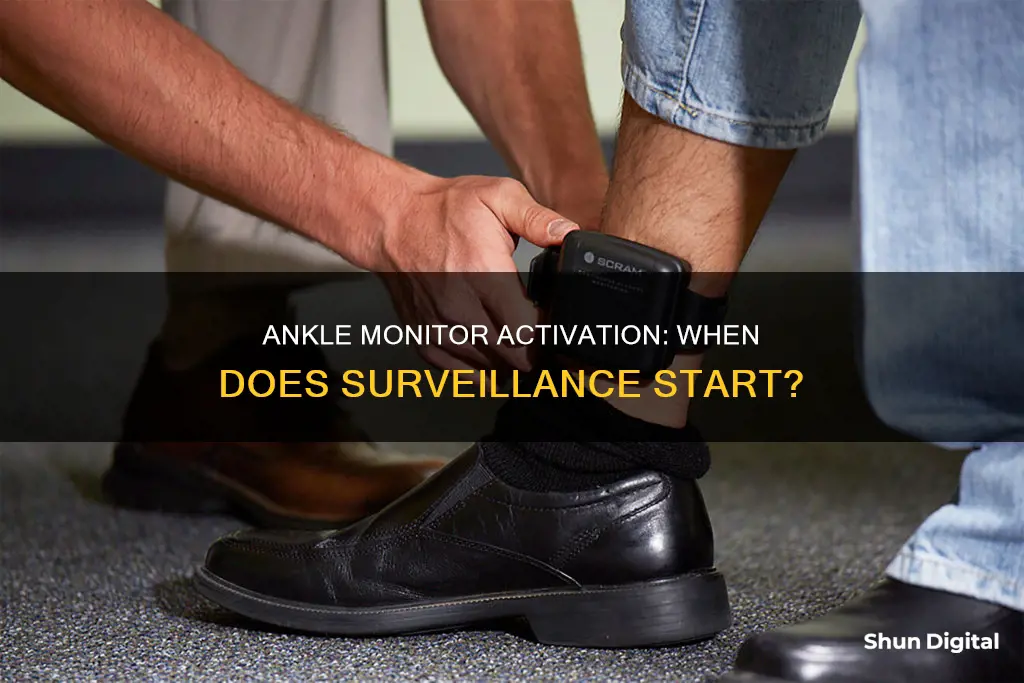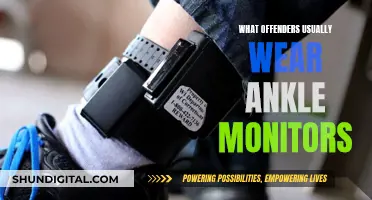
Ankle monitors are used as an alternative to prison sentences, typically for non-violent crimes, and are often employed in cases of substance abuse issues, DUI, or as a condition of probation. They are also used to ensure that individuals stay within a designated area and maintain a required distance from specific people, such as victims of domestic violence. By tracking the movements of individuals with restricted travel or activities, ankle monitors help deter repeat offences and ensure compliance with court-ordered conditions. The device is usually strapped to the lower leg and can detect alcohol consumption by testing the wearer's sweat.
What You'll Learn

Ankle monitors are used as an alternative to jail time for low-risk offenders
Ankle monitors are increasingly being used as an alternative to jail time for low-risk offenders. They are often used for individuals on probation or parole, or those awaiting trial. They can also be used for people convicted of a crime but deemed low-risk and not a danger to the community.
Ankle monitors are typically worn around the lower leg and use GPS technology to track an individual's movements and location. They are usually about the size of a pager and are strapped to the ankle with a tamper-proof band. The devices can be used to ensure that individuals adhere to specific rules and regulations, such as sticking to a particular area, avoiding certain people, or adhering to a curfew. They can also be used to monitor sobriety, with Secure Continuous Remote Alcohol Monitors (SCRAM) bracelets detecting alcohol in a person's sweat.
The use of ankle monitors as an alternative to jail time has several advantages. It is less expensive than incarceration, and it allows individuals to maintain their jobs, continue their education, and support their families. This can facilitate their reintegration into society upon completion of their sentence. Additionally, ankle monitors can help deter people from reoffending and reduce the risk of recidivism.
However, there are also disadvantages to ankle monitors. They can be uncomfortable to wear and may cause skin irritation. Individuals with ankle monitors are subject to strict rules, and any violation of these rules can result in additional penalties or even imprisonment. The cost of the devices can also be a burden, with private companies charging defendants hundreds of dollars a month to wear them. If people cannot pay, they may end up back in jail.
While ankle monitors can provide an alternative to jail time for low-risk offenders, it is important to consider the financial implications and potential infringement on civil liberties.
Troubleshooting an ASUS Monitor with No HDMI Signal
You may want to see also

They can be used to ensure an individual maintains a required distance from a person
Ankle monitors are often used as a surveillance tool to ensure that individuals on parole or house arrest comply with court-ordered movement restrictions. They can be used to ensure an individual maintains a required distance from a person, such as in cases of domestic violence, where the offender must stay away from the victim. In such cases, the ankle monitor serves as a tool to enforce a restraining order.
The ankle monitor uses GPS technology or radio frequency to transmit location data to a monitoring center. This allows authorities to ensure that the individual wearing the monitor does not enter areas or come within a certain distance of specific individuals. If the individual attempts to do so, the monitor will notify them with a vibration or a loud tone, and if they do not move away, an alert will be sent to the authorities.
In addition to maintaining distance from specific people, ankle monitors can also be used to enforce other restrictions, such as curfews or designated safe areas. They can also be used to detect alcohol consumption, which is especially useful for enforcing restrictions on individuals with alcohol-related offenses.
The use of ankle monitors allows for the supervision of an individual's location without the need for constant physical surveillance by a law enforcement officer. This technology provides a level of flexibility and controlled freedom for the wearer while also ensuring that they comply with the court-ordered restrictions.
While ankle monitors can be an effective tool for enforcing distance restrictions and protecting victims, it is important to note that studies have shown that they may be less effective in rehabilitating offenders and preventing recidivism compared to other programs. Additionally, the fees associated with wearing an ankle monitor can be a significant financial burden, especially for individuals from low-income households.
Touchscreen Monitors: Who's the Top Buyer?
You may want to see also

They can be used to monitor sobriety
Ankle monitors, also known as alcohol monitoring bracelets or sobriety tags, can be used to monitor an individual's sobriety. These devices are often court-ordered for people who have been convicted of alcohol-related offences or as a condition of probation or parole. They are sometimes also used in treatment programs for individuals struggling with alcohol addiction.
The ankle monitor works by detecting the presence of alcohol in the wearer's sweat through a process called transdermal alcohol testing. This technology provides an accurate and continuous way to monitor sobriety, as alcohol is excreted through the skin even after it has been metabolized by the body. The device typically takes readings at regular intervals, such as every 30 minutes, and transmits the data to a monitoring centre.
If the ankle monitor detects any presence of alcohol, it will trigger an alert, and the relevant authorities or treatment providers will be notified. This allows for swift intervention and accountability, which is crucial for individuals in recovery or those who need to maintain sobriety as a condition of their release. The ankle monitor serves as a constant reminder and deterrent, aiding individuals in staying on track with their sobriety goals.
In addition to transdermal alcohol testing, some ankle monitors may also incorporate features such as GPS tracking. This enables authorities to not only monitor an individual's sobriety but also their location, ensuring adherence to any court-imposed geographical restrictions. The combination of sobriety monitoring and location tracking provides comprehensive oversight of the wearer's activities, allowing for better decision-making regarding their case or treatment plan.
The use of ankle monitors for sobriety checks has proven effective in promoting accountability and supporting individuals on their path to recovery. By providing continuous and accurate data, these devices help ensure compliance with court orders or treatment programs, ultimately contributing to a safer and healthier community. For those striving for sobriety, ankle monitors offer a means to demonstrate commitment and facilitate their journey towards positive behavioural changes.
Finding a Monitor for Your Old MacBook Air
You may want to see also

They are cheaper than jail time
Ankle monitors are often seen as a cheaper alternative to jail time. In recent years, legislators have embraced them as an enlightened alternative. In Washington State, for example, they have become popular as they are cheaper and they work to deter people from reoffending.
However, this cheaper alternative comes at a cost to the individual. People on ankle monitors must pay for the privilege of wearing them, with fees ranging from $5 to $25 a day. In some cases, these fees can be more than a person's monthly rent. In addition, if a person cannot pay, they may end up in jail.
In some states, the cost of the monitor is covered by the state. In others, the individual is forced to pay for it themselves as part of their sentence. In St. Louis, for example, defendants must pay a private company $10 a day for their ankle monitor. This can create an extraordinary and arbitrary expense for poor defendants, who may struggle to find the money to pay for their own supervision.
Ankle monitors can also come with a host of other restrictions and rules that must be adhered to. For example, a person with an ankle monitor may be restricted to a certain area and must regularly check in with their probation officer. They may also be required to refrain from drinking alcohol, with the monitor tracking their indulgence and relaying this information to the authorities.
While ankle monitors are indeed cheaper than jail time, this saving is often passed on to the individual, who must pay for the device and the privilege of staying out of jail.
Monitoring Water Usage: A Guide for Property Owners
You may want to see also

They can be used to reduce bail
Ankle monitors can be used to reduce bail by providing an assurance to the court that the defendant will not flee and will appear for their day in court. This can increase the chances of the court granting a lower bail amount or even no bail at all.
For example, if the bail amount is $5,000 and the bail bond service charges a 15% fee, the defendant will incur an additional non-refundable $750 charge. However, if the defendant agrees to wear an ankle monitor, the court may reduce the bail amount, leading to lower fees for the defendant. The ankle monitor acts as a condition of the bail, allowing the defendant to remain out of custody while awaiting trial.
The use of ankle monitors can also provide benefits to bail bond companies, as it gives them greater certainty that the defendant will appear for court proceedings and reduces the risk of bail bond forfeiture. This can make bail bond companies more comfortable with the idea of providing a bail bond and may increase the likelihood of bail being granted.
In addition to reducing bail, ankle monitors can also be used as an alternative to a jail sentence for low-risk offenders or as a condition of probation. This allows individuals to avoid incarceration while still being monitored and ensuring compliance with court orders.
Troubleshooting LCD Monitor Backlight: Repairing a Dark Screen
You may want to see also







